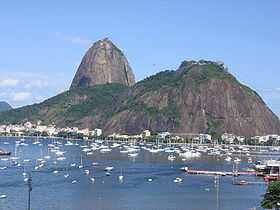Monadnock
A monadnock /məˈnædnɒk/ or inselberg is an isolated rock hill, knob, ridge, or small mountain that rises abruptly from a gently sloping or virtually level surrounding plain.
In southern and southern-central Africa, a similar formation of granite is known as a kopje, a Dutch word ("little head") from which the Afrikaans word koppie[1] was derived.
If the monadnock is dome-shaped and formed from granite-gneiss, it can also be called a bornhardt.
Definitions
Monadnock is an originally Native American term for an isolated hill or a lone mountain that has risen above the surrounding area, typically by surviving erosion. Geologists took the name from Mount Monadnock in southwestern New Hampshire.[2] It is thought to derive from the Abenaki language, from either menonadenak ("smooth mountain") or menadena ("isolated mountain").[3] In this context, monadnock is used to describe a mountain that rises from an area of relatively flat and/or lower terrain. For instance, Mount Monadnock rises 2,000 feet (610 m) above its surrounding terrain and stands, at 3,165 feet (965 m), nearly 1,000 feet (300 m) higher than any mountain peak within 30 miles (48 km).[4]
.jpg)
Geology

Volcanic or other processes may give rise to a body of rock resistant to erosion, inside a body of softer rock such as limestone which is more susceptible to erosion. When the less resistant rock is eroded away to form a plain, the more resistant rock is left behind as an isolated mountain. The strength of the uneroded rock is often attributed to the tightness of its jointing. If the monadnock is dome-shaped and formed from granite-gneiss, it can also be called a bornhardt.[7]
The presence of a monadnock or inselberg typically indicates the existence of a nearby plateau or highland, or their remnants. This is especially the case for inselbergs composed of sedimentary rock, which will display the same stratigraphic units as this nearby plateau. However once exposed, the inselbergs are destroyed by marginal collapse of joint blocks and exfoliation sheets. This process leaves behind tors perched at their summits and over time a talus-bordered residual, known as a castle kopje appears.[8] [9]
Ecology
The kopjes of Eastern Africa tend to be a refuge for life in the Serengeti of Tanzania and Kenya. Where the soil is too thin or hard to support tree life in large areas, soil trapped by kopjes can be dense with trees while the surrounding land contains only short grass. Hollows in the rock surfaces provide catchments for rainwater.[10] Many animals have adapted to the use of kopjes, to include the lion, hyrax, and an abundance of bird and reptile life.



See also
References
- ↑ Webster's New Explorer Dictionary of Word Origins (2004). Federal Street Press: New York.
- ↑ Raymo, Chet and Maureen E. (1989) Written in Stone: A Geologic History of the Northeastern United States. Globe Pequot, Chester, Connecticut.
- ↑ "Vermont Soils with Names of American Indian Origin" United States Department of Agriculture, Natural Resources Conservation Service. Retrieved January 6, 2008.
- ↑ Baldwin, Henry I. (1989). Monadnock Guide 4th edition. Concord, New Hampshire: Society for the Protection of New Hampshire Forests.
- ↑ Holmes, Arthur (1978). Holmes Principles of Physical Geology Taylor & Francis: New York.
- ↑ Gerrard, John (1988). Rocks and Landforms Routledge: Florence, Kentucky.
- ↑ "A Dictionary of Ecology" (2004). Encyclopedia.com. Retrieved November 28, 2009 <http://www.encyclopedia.com>
- ↑ "Summary: Inselbergs/Hills/Knobs" Desert Processes Working Group; Knowledge Sciences, Inc. Retrieved January 6, 2008.
- ↑ Easterbrook, Don J. "Chapter Three: Weathering." Surface Processes and Landforms. 2nd ed. Upper Saddle River, NJ: Prentice Hall, 1999. 45. Print.
- ↑ Serengeti National Park Visitor Center, Tanzania
External links
| Wikimedia Commons has media related to Monadnocks. |
-
 Chisholm, Hugh, ed. (1911). "Monadnock". Encyclopædia Britannica (11th ed.). Cambridge University Press
Chisholm, Hugh, ed. (1911). "Monadnock". Encyclopædia Britannica (11th ed.). Cambridge University Press
